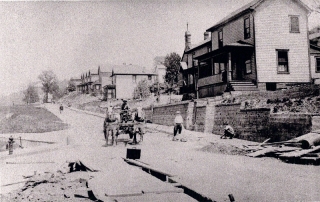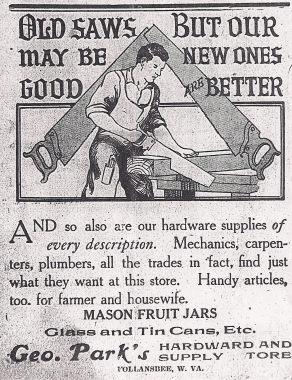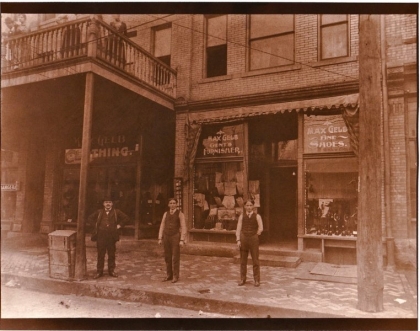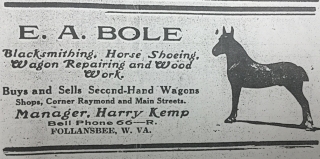The citizens of Follansbee petitioned for a change in the status of the city Post Office from a county branch of Wellsburg to an upgraded independent facility able to provide free mail delivery to homes by mail carriers. At the time, residences had to go to the local Follansbee branch post office to get their mail. During 1913, the city council passed an ordinance requiring all homes to have numbers or addresses, making free postal delivery possible.
June 1913 – Fraternal Order Of Eagles Gives Gifts To City
The Eagles’ Lodge presented the city with two drinking fountains, one for human consumption placed near the city park at the corner of Penn and Main streets.
The other fountain was constructed with a drinking trough for horses and a lower lapping trough for dogs. It was located at the Eagles’ park, adjoining their hall and clubrooms on the corner of Penn Street and Virginia Avenue. The gift was intended to celebrate the 50th Birthday of the State of West Virginia on June 20. 1913.
- Mill Towns Review, “The Eagles’ Fountains…,” June 6, 1913, front page.
June 1913 – Efforts To Improve The City’s Image
The boosters of Follansbee asked the citizens to “boost your own town first …and let our motto be, Upward, Onward, and Forward! Follansbee, thou art near and dear to me!”
During 1913, the city awarded Mike McMahon & Sons of Wellsburg the contract for brick paving and cement curbing of some city streets including portions of south Main, Neville, Ohio, Penn and Raymond streets. Later in 1915 McMahon was again in the news when he opened a new meat market in the Buccalo building at 646 Main near Broad Street.
A large force of men were working on Allegheny and Neville streets, blasting out rocks and leveling some lots to be put on the market for buildings. Joe Zago was the general contractor whose men built the concrete retaining wall on the east side of Virginia Avenue. The wall, that can still be seen today, extended from Ohio to Broad Street. The Mill Towns Review noted, “It’s a big job, but not too big for Joe.”
Joe Zego was also responsible for the retaining wall that was built along Allegheny. An ordinance was also passed to issue bonds for the making of sanitary sewers in streets on the east side of town.
- Mill Towns Review, “A $25,000 Contract Awarded McMahan & Sons..,” June 6, 1913, front page.
- Mill Towns Review, See Personals section – Joe Zago, August 8, 1913, front page.

Road, and sidewall construction at intersection of Jefferson and Neville in Follansbee circa 1915. Photo courtesy of W. Va. State Archives.
June 6, 1913 –First Fire Engine Seen in Follansbee
Fire trucks have always captured the fascination of young and old since the advent of the exciting horse drawn steam pumpers. In 1913 the Follansbee Review described the thrill city folks experienced upon seeing the first gasoline powered fire truck speed along Main Street. “The first auto fire truck seen in Follansbee “rumble and a streak of red was the impression left by the new auto hose truck from Steubenville as it flashed down Main Street. Chief Barnes was asked why he did not stop the fire wagon and arrest the driver for speeding but the chief replied that it was impossible for the machine was gone before he knew it was coming, and Chief Barnes isn’t slow when attending to his duties either. Hundreds of people ran into the streets attracted by the strange noise and watched until the truck passed by on its way to Steubenville. Still, it was going some although it probably cut its former speed down to thirty miles an hour – more or less.”
May 1913 –The Fabulous George Park’s Hardware Store

Even today folks recall stories of George Park’s Hardware & General Supplies store on the corner of Main and Ohio streets. George Park purchased the Johnston Hardware store in 1913. The following quote describes Park’s Hardware store as told by an eyewitness. “In that large area of apparent confusion and disorder, George could locate whatever the customer wanted. A pack of ten-penny nails sat beside gleaming modern kitchen appliances. One could be assured if no one else had (sic) ‘it’ the Park Hardware did!”
- Quote taken from Secretary notes of Follansbee City Council meetings
May 1913 – Eight Students Graduate From FHS
The city praised the graduating students with an automobile parade and banquet at the Eagle Hall. Gilbert Follansbee was in attendance. The following day, the students attended an inter-denominational service held at the Methodist Episcopal church. The sermon to the class was delivered by Rev. T. C. Pears of the First Presbyterian Church. Rev. Norman W. Philips of the Christian Church read the scripture and the benediction was given by the Rev. A. Cremonesi of the Italian Presbyterian mission. The eight graduates were Elmer Jackson, Helen Krager, Zelda Richardson, Mildred Parry, Guilym Jones, Robert Davies, Mamie Grossman, and Lynn Gill.
The graduates occupied a front pew as the address to the class was delivered by Prof. W.B. Taylor, vice president of Bethany College. He took as his theme “The Dreamers.”
The Salutatory was delivered by Helen Gertrude Krager. The valedictory address was given by Guilym Jones. The instrumental music for the commencement was by the Imperial Orchestra of Steubenville.
- Mill Towns Review, “Second Annual Banquet of Follansbee High..,” May 30, 1913. p. 4.
- Mill Towns Review, “Diplomas Given To 8 Graduates, “May 30, 1913, front page.
May 9, 1913 – Fraternal Order Of The Eagles Memorial
Each year the F.O.E. paid respect to the departed members. The 1913 Memorial was held at the Grand Theatre in Steubenville. The Hon. Robert L. Ramsey represented Follansbee’s Eagles Lodge and their departed member, W. B. Jones. Ramsey was Follansbee’s first city solicitor and city sergeant. During the 1920s, he was the Prosecutor in the famous Madame Stanley murder trial (See October 1922 on timeline).
His eloquent memorial presentation included the following lines.
“Death has no more mystery than life. Both are inevitable. In life man is mortal and is bound to die. Our order represents the best in civilization. Progress goes on in carrying out God’s final purposes. Each generation takes its step beyond the one that has gone on before. There never was a life that did not gather about it some love and sympathy and leave an impression on its generation either for good or bad. All great nations have honored their great men by statues. The life beyond the grave has challenged the thought of the theologian and the philosopher. The quiet voice convinces us that there is a life beyond the grave. The struggle between belief and unbelief is as strong today as ever before. The principles of this ordeal are founded on the Bible. Our simple faith teaches us that there is a beautiful life somewhere. We shall meet our departed brothers face to face in the hereafter. Our high obligations should strengthen our arm for the time when the death summons comes.”
- Mills Town Review, “F.O.E. Memorial,” May 9, 1913, front page.
1913 – Weisberger Family Comes To Follansbee
The Weisberger family has served the city of Follansbee for more than a hundred years. In 1913, Herman Weisberger came to the city and opened a clothing store. However, in 1918 he sold out to the Walter Miller of the Union Mercantile Company. In 1929, Herman’s son Morris Weisberger returned to the city opening a family clothing store. In 1937 David Weisberger assumed management. David and his three brothers, Fred, Sidney and Morris, expanded the business of their father Herman from its Mingo Junction roots to Weirton, Steubenville and Follansbee prior to World War II. “The Follansbee store is the sole remaining Weisberger location…” Following in the footsteps of his uncle David Weisberger, Arnold Plittman became owner of Weisberger’s Clothing Store in the 1970s. The store continues to offer a wide variety of men’s clothing from sportswear and work-related clothing to suits and tuxedos. The store is located at 709 Main Street.
ADDITION TO STORY OF WEISBERGER’S MEN’S STORE IN FOLLANSBEE
Mark R. Weitzman provided the following additional background regarding Herman Weisberger and the evolution of Follansbee’s Weisberger store.
Herman Weisberger was a nephew of Max Gelb. Max Gelb started his clothing store in Mingo Junction Ohio in 1884. He brought his nephew Herman to this country and employed him in the Gelb Clothing store eventually bringing him on as a partner in 1907. This partnership eventually included Ed Klein, who was Max Gelb’s brother-in-law. Max Gelb eventually sold the business to Herman Weisberger and Ed Klein in 1911. Max Gelb moved to Cleveland Ohio at that time but continued to own property and investments in the Mingo/Steubenville area. He also owned an equal 1/3 share as a silent partner in the Union Mercantile located in Follansbee. The Union Mercantile Company eventually became Weisberger.

Max Gelb’s store in Mingo Junction Year abc. 1907. From left to right: Max Gelb, Ed Klein, and Herman Weisberger.
- Mark R. Weitzman, grandson of Max Gelb, provided the above photo of the 1907 Gelb Clothing store in Mingo later sold to Weisberger and Klein.
- Mill Towns Review, “Review of the Week,” (Herman Weisberger), September 4, 1914, p. 4.
- Steubenville Herald Star, “Weisberger’s Quality clothing since 1927,” February 28, 2001.
1913 – The Town’s Blacksmiths
Well into the 1930’s folks depended upon horses and horse drawn wagons and buggies for transportation. Blacksmiths were very important to every day life. They were talented with metals and iron and experts when dealing with horses. They could repair or make almost anything of metal, such as buggies, sleighs, and wagon wheels. One of the earliest documented blacksmiths in Follansbee was Raymond Walker whose occupation was listed in the 1908 Follansbee-Wellsburg City Directory.
In 1913, E. A. Bole’s blacksmith shop was on the corner of Main and Raymond streets. Harry Kemp was Manager. E. A. Bole advertised in the city paper, offering services such as horse shoeing, wagon repairing and wood work. He also bought and sold second-hand wagons. George Chansky also operated a blacksmith shop on Allegheny Street.
 Photo - Follansbee Review 1912
Photo - Follansbee Review 1912
Follansbee Mill Blacksmiths
Samuel L. Tuner was a Follansbee Mill Blacksmith who died in 1919. He assigned the use of horses an mules for various mill projects. The stables were at the corner of Mill Alley and Broad Street.
Nicholas Hindman of the Tent Church community operated a blacksmithing and tool making business on the Tent Church road for nearly a half century. In 1931, the Follansbee Review reported that on one of his last visits to town he stopped by the newspaper office and presented the editor with a valuable carving knife that he had crafted.
By the mid 1930s blacksmith shops declined as horses were replaced by automobiles. Poet Bessie Wheeler’s poem remembers the era of the blacksmith.
“The blacksmith shop stands by the side of the road, Where it’s stood most a century before, But its doors are closed and its roof is sagged. And the anvil will ring no more.”- http://www.kennet.pe.ca/chip/english/business/blacksmith.htm
- Follansbee Review, “Editor Gets Knife,” July 30, 1931, p. 1.
- Follansbee City Directory – 1908-1910, See Raymond Walker, Kirk & Reffner, 1908, WVU Archives.
1913 – The Boosters Of The Knights Of Pythias Lodge 110
The K. of P. became the major sponsor for the annual city Jubilee beginning in 1914. The Lodge was instituted on March 7, 1914 with a charter membership of 87. “At that time it was the largest charter list ever submitted in the state of West Virginia.” Initially organized in 1913, the membership grew to 265 by 1920. Within two years of its charter date, the local lodge had purchased and paid for two lots located on Main near Ohio street in the heart of the town’s business section. The Boosters of K. of P. laid the plan for the annual city Jubilees which were held in September on the streets of Follansbee and the K. of P. lots. Each year, the Boosters out-did themselves as the spirit behind the Jubilees increased and the city became known as “The Little Town That Does Big Things.” The Jubilees were big fundraisers for the city and attracted thousands to see the motorcycle and car races, water battles, boxing matches, band concerts, a great steam driven Merry-Go-Round and other amusements.
During World War I, the Lodge made purchases of $3,500 worth of U.S. Liberty Bonds, besides individual purchases by members. The Lodge also gave substantial donations to the Red Cross and to the Welcome Home City Celebration in honor of returning Brooke County servicemen in 1919. On the national level, the Knights of Pythias was founded in 1864. It was the first fraternal order to be chartered by an act of Congress. Its distinguishing principles of Friendship, Charity, and Benevolence energized the spirit of Follansbee.

Cecil Lusk (up-front) served in the “Rainbow Division.” In winter 1918, the division fought from the trenches stopping the final German offensive of the war.

- Steubenville Herald Star, “Follansbee Section,” September 17, 1920, p. 5.
- Steubenville Herald Star, “Rainbow Division Photo,” Oct. 17, 1919, p. 5.